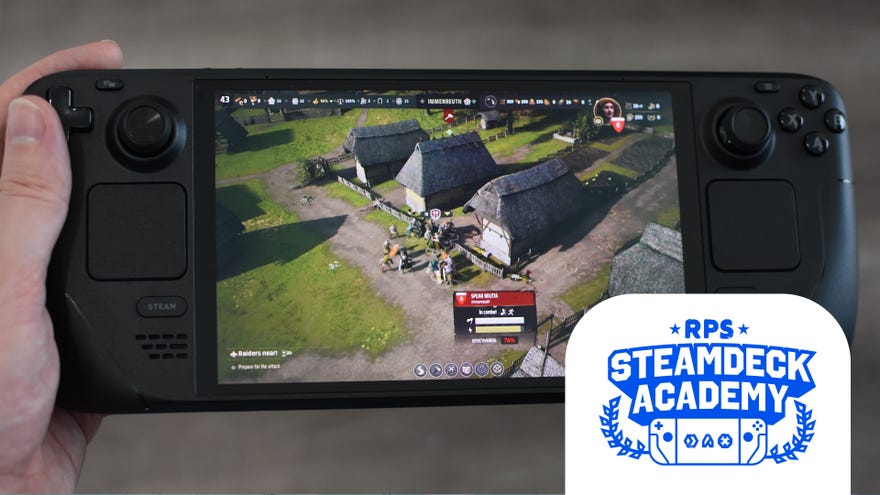HomeHardwareFeaturesManor Lords
Manor Lords performs fine on Steam Deck – it’s the controls you’ll want to watch out forContort your thumbs now, my lord
Contort your thumbs now, my lord
Image credit:Rock Paper Shotgun
Image credit:Rock Paper Shotgun

The current input setup for the Steam Deck is, most part, functional. You can move the camera with the left stick and prod the cursor around with the right trackpad and spin tannery plots around with R2, which is right-click for some reason. It’s enough to get a village going or to send militia units into battle, among other typical, manor-owning lord activities.
Image credit:Rock Paper Shotgun

Steam Deck Academybrings together all our guides and explainers on getting the most out of your Steam Deck, no student loans or sweaty dormitories required.
I also found the default trackpad sensitivity on the low side, and while that’s also a simple fix, it doesn’t truly change how Manor Lords will wear down your thumb faster than most Steam Deck games. Everything –everything– needs to be selected with the cursor, with no help from the D-pad and only very situational help from the face buttons. Again, it technically works, but it’s not as comfortable as citybuilders/management sims with more fleshed-out gamepad support, likeTropico 6orRimWorld. Nor do the on-screen mouse and keyboard prompts switch to Deck-appropriate icons, so you may need to refer back to that controller settings menu if you forget a command.
Ctrl? Alt? I don’t have any of these! |Image credit:Rock Paper Shotgun
Controller support is good for both handheld PCs andaccessibility hardware, so hopefully that can be improved upon throughout Manor Lords’ stint in early access. The good news is that more generally, very little else needs changing in pursuit of ideal Steam Decking. Good performance is attainable without gutting the quality settings (more on this below), the install size is small enough not to trouble crampedSSDsormicroSD cards, and the 800p display is surprisingly capable of keeping everything readable. Relievingly, Steam cloud saves have also been enabled, just days after our review code showed up with this feature missing, so you can keep on buildin’ and taxin’ the same town across your Steam Deck and desktop PC.
It miiiiiight be something of abatteryhog, as it drained mySteam Deck OLEDfrom full charge to empty in 2h 05m. Judging from other games that were similarly thirsty, most closelyHelldivers 2andLike a Dragon: Infinite Wealth, that likely translates into around 1h 10m to 1h 30m on the original, LCD-screened Deck. In fairness, Manor Lords does need to simulate the entire lives of an awful lot of 3D serfs, and there’s a good chance your digits will grow tired before your Steam Deck does.
Image credit:Rock Paper Shotgun
Manor Lords: Steam Deck best settings guide
Manor Lords is sufficiently tuned to low-end PC hardware that it can run playably on the Steam Deck without slamming everything down to Low. In fact, you can keep more than a few individual settings on High or Ultra, as lowering them further doesn’t appear to speed up performance at all. Except, um, the bounced light approximation toggle, which is currently bugged into self-reverting to Ultra.
Fear not the abundance of approximated bouncy lights, though, as FSR upscaling plus a few tweaks to Medium – and one to Low – will get the Steam Deck running Manor Lords around 40-45fps while citybuilding. Framerates will fall with the camera zoomed right in on your subjects’ unwashed faces, and/or getting up close in a battle, but with the settings below, I seldom saw it drop below 30fps.
I’ve gone for slightly deeper cuts than in my desktop settings guide, as the Steam Deck’s APU proved more sensitive to certain settings than any full-blown graphics card did. Chiefly, shader quality is best off on Low – everything is still playable on Medium, but there’s a touch more stuttering, and at (upscaled) 800p the quality difference is harder to spot anyway. Terrain texture resolution is also worth taking down a step, just to gain a couple of frames-per-second while you’re zoomed in close to the ground. That might not sound like a lot, but during battles, it proved the difference between sticking to 30fps and falling below.
Since we’re talking settings, don’t forget to go into the Steam menu’s controller settings to assign a middle mouse button! You don’t have to use a rear button, like I did – it could be a D-pad direction, shoulder button, or even one of the left trackpad directional clicks. Basically, anything you can hold while your right thumb spins the camera around.